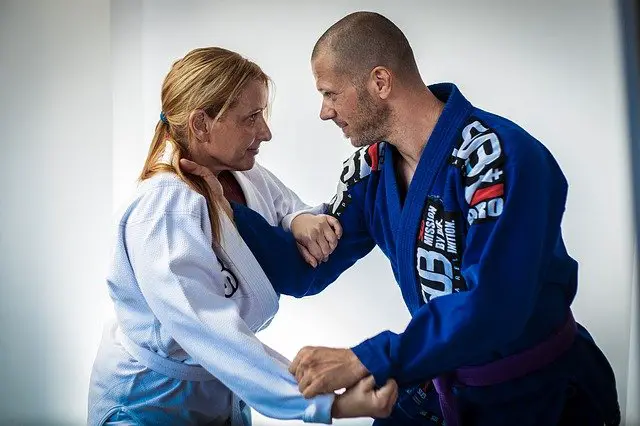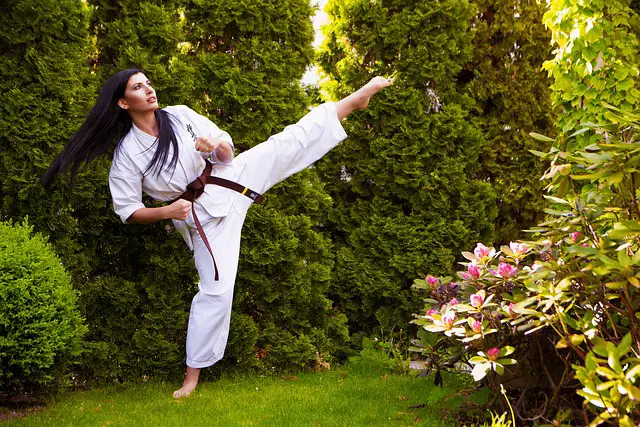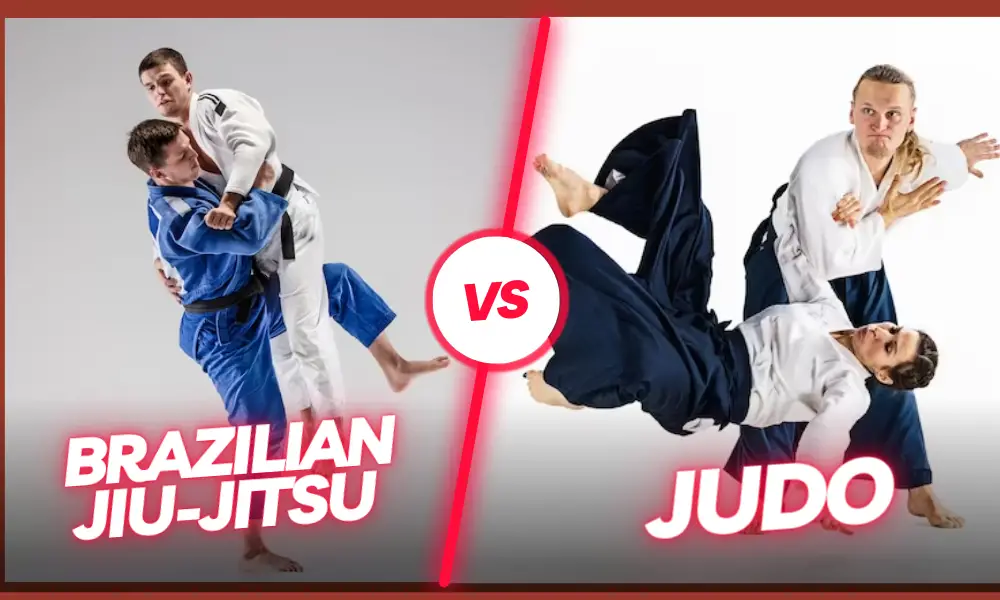Brazilian Jiu-Jitsu (BJJ) and Judo are two popular martial arts that originated in Japan. Both BJJ vs Judo involves grappling and submission techniques and they share many similarities in terms of their techniques and training methods.
However, there are also some significant differences between the two martial arts. In this comparison, we will explore the similarities and differences between BJJ VS Judo, including their origins, techniques, rules, training methods, and competition formats.
Whether you are a beginner or an experienced martial artist, this comparison will help you understand the unique aspects of each martial art and make an informed decision about which one to pursue.
That’s what you’re going to find out in this complete comparison between BJJ VS Judo!
What is BJJ?

Are you a pretty chill person who doesn’t want anyone to get hurt?
At least, not THAT much.
If yes, do you want to have a bit of fun messing around with whoever’s bullying you?
If that’s the case, then Brazilian Jiu-Jitsu’s the perfect self-defense for you!
In Brazilian Jiu-Jitsu (or BJJ), what you’re looking to achieve in a fight is a submission from your opponent.
Locking, leg-sweeping, choking—these are some of the techniques that can give you the upper hand in a match.
Speaking of matches, in an official one, there’s a scoring system based on specific techniques for you to be the victor by the end of it!
Two points for either a takedown, a sweeping, or attaining a knee-mount position. Three points are for passing your opponent’s guard.
And the highest is four points, wherein you get that from either pinning your opponent on their back to the floor or mounting them fully and with proper control.
Sure, it’ll take some time to tire out your opponent, so training for BJJ will definitely build up your endurance.
And you’ll learn to acknowledge your surroundings more because practicing BJJ makes you appreciate just how vital the ground you’re standing on truly is!
Since you’re familiar with being pinned down, the ground becomes another limb for any BJJ student when you use it as a support to change the tides of your fight.
Of course, this means you’ll need a uniform (or any set of clothes) to confirm your figure snugly so it won’t snag anywhere else.
- For submission
- Takes some time
- Score-based win
- Uses groundwork
- Wears fit uniform
What is Judo?

Whereas BJJ prioritizes a slow (and steady) descent to submission, Judo is much more fast-paced in that regard.
Meaning, you get to learn how to throw your opponent to take them down.
This is perfect for when you’re getting ganged up on!
Here, being forceful is a must to have the upper hand, so all you need to focus on is your opponent and nothing else.
Because you’ll be on your toes a lot more, a looser uniform is required to be worn for more movement.
But watch out, though! Looser clothes make it easier for your opponent to grab onto them for leverage.
And you can totally use this to your advantage when your opponent’s wearing something as loose as yours, too!
This makes the match last nothing more than a few seconds, so you better be on your guard!
- Forceful
- Quick takedown
- Wear loose uniform
| Aspect | Brazilian Jiu-Jitsu (BJJ) | Judo |
|---|---|---|
| Origin | Developed in Brazil in the early 20th century from Judo and other grappling styles | Developed in Japan in the late 19th century from traditional Jiu-Jitsu |
| Techniques | Emphasis on ground fighting, submissions, and positional dominance | Emphasis on throws, takedowns, and grappling techniques |
| Uniform | Practitioners wear a gi (uniform) similar to Judo, but often made of a heavier material and with less rigid regulations regarding patches and design | Practitioners wear a gi (uniform) that adheres to strict regulations regarding color, design, and patches |
| Scoring | Points are awarded for various positions and submission attempts | Points are awarded for throws, takedowns, and various positions, with submission attempts being a secondary factor |
| Rules | Submissions allowed in competition, with restrictions on certain techniques | Certain techniques such as leg locks and neck cranks are not allowed, and competitions may have additional rules |
| Training | Focus on live sparring and positional drilling, often with a significant amount of time spent on the ground | Emphasis on technical drilling and live sparring, with a balance between ground and standing techniques |
| Competition | Gi and no-gi competitions are available, with tournaments ranging from local to international level | Gi competitions are the norm, with major tournaments such as the Olympics and World Championships held at the international level |
| Overall focus | Ground-based grappling and submissions, with a self-defense aspect | Throws, takedowns, and grappling techniques, with a focus on competition |
Note that these are generalizations, and different schools or practitioners may have different approaches to training and competing.
Similarities BJJ VS Judo
Down to the Roots
Did you know BJJ VS Judo are from the same parent?
Well, maybe it’s not that big of a revelation when those who don’t know any better tend to confuse the two.
And it’s all because they are the offspring of their martial art parent, Jujitsu.
Now, Jujitsu stemmed from a time long, long ago when samurais were still a thing in Japan, and they designed an effective technique that could defeat their enemies in case of weapons shortage.
Hence, Jujitsu is roughly translated to “gentle art.”
This is ironic, given how much armor samurais wore.
So, instead of a “gentle touch” from a “gentle art,” these enemy samurais get thrown to the ground, trapped in a lock, or every technique to keep the opponent down despite being armored.
Talk about fierce, am I right?
Take ‘Em Down!
Although different techniques do it, one of the objectives of either martial arts is to take down your opponent!
Whether you do this by punching them back down, you can say it’s not as much of a priority for BJJ when there are many ways to score in an official match.
Not the same can be said for Judo, though.
Nice and Precise
To distribute every one of your techniques properly, you’ll need to be particular about each one!
Certainty brings confidence in your movements, and it’s this confidence that will make you win a match.
Because you can’t be a wuss when you’re supposed to be pulling your opponent’s strings or be weak-willed when you’re about to throw your opponent somewhere.
Being confident gives you a reason to focus more on where you’re hitting, landing more damage once you contact the right spot.
In turn, a cleaner defeat is what you get!
And whether you’re a beginner prone to mistakes or a professional, you deserve every single second of it after honing your skills to boost your confidence as a martial artist.
Final Words
Self-defense is extremely important. So, if you want to know HOW to practice it, you have to be entirely sure which one you’re comfortable with.
BJJ will be perfect for you if you like to take your time “marinating” your opponent first before they surrender all by themselves.
And Judo’s fantastic for that incredible, cliché moment of fighting a bunch of punks all at the same time since it has you light on your feet and throwing your opponents around, left and right.
As you can see, there’s no real winner in the whole “BJJ VS Judo” argument because both of these styles can complement different kinds of people.
If anything, the winner here all along is YOU for being brave enough to try out these martial arts! So go pat yourself on the back!

